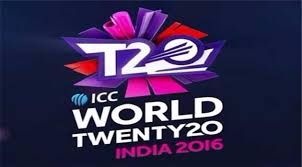ICC World Twenty20
The ICC World Twenty20 (also referred to as the World T20, and wrongly as the T20 World Cup) is the international championship of Twenty20 cricket. Organised by cricket's governing body, the International Cricket Council (ICC), the tournament currently consists of 16 teams, comprising all ten ICC full members and six other associate or affiliate members chosen through the World Twenty20 Qualifier. The event has generally been held every two years, although there is a four-year gap between the next two scheduled tournaments (2016 in India and 2020 in Australia). All matches played are accorded Twenty20 International status.
History
Main article: History of the ICC World Twenty20
Background
When the Benson & Hedges Cup ended in 2002, the ECB needed another one day competition to fill its place. Cricketing authorities were looking to boost the game's popularity with the younger generation in response to dwindling crowds and reduced sponsorship. It was intended to deliver fast paced, exciting cricket accessible to thousands of fans who were put off by the longer versions of the game. Stuart Robertson, the marketing manager of the ECB, proposed a 20 over per innings game to county chairmen in 2001 and they voted 11–7 in favour of adopting the new format.[4]
Twenty20 Internationals
Main article: Twenty20 International
On 17 February 2005 Australia defeated New Zealand in the first men's full international Twenty20 match, played at Eden Park in Auckland. The game was played in a light-hearted manner – both sides turned out in kit similar to that worn in the 1980s, the New Zealand team's a direct copy of that worn by the Beige Brigade. Some of the players also sported moustaches/beards and hair styles popular in the 1980s taking part in a competition amongst themselves for best retro look, at the request of the Beige Brigade. Australia won the game comprehensively, and as the result became obvious towards the end of the NZ innings, the players and umpires took things less seriously – Glenn McGrath jokingly replayed the Trevor Chappell underarm incident from a 1981 ODI between the two sides, and Billy Bowden showed him a mock red card (red cards are not normally used in cricket) in response.
Inaugural tournaments
Lasith Malinga bowling to Shahid Afridi in the 2009 Final at Lord's.
It was first decided that every two years an ICC World Twenty20 tournament is to take place, except in the event of an Cricket World Cup being scheduled in the same year, in which case it will be held the year before. The first tournament was in 2007 in South Africa where India defeated Pakistan in the final. Two Associate teams had played in the first tournament, selected through the 2007 ICC World Cricket League Division One, a 50-over competition. In December 2007 it was decided to hold a qualifying tournament with a 20-over format to better prepare the teams. With six participants, two would qualify for the 2009 World Twenty20 and would each receive $250,000 in prize money.[14] The second tournament was won by Pakistan who beat Sri Lanka by 8 wickets in England on 21 June 2009. The 2010 ICC World Twenty20 tournament was held in West Indies in May 2010, where England defeated Australia by 7 wickets. The 2012 ICC World Twenty20 was won by the West-Indies, by defeating Sri Lanka at the finals. For the first time, a host nation competed in the final of the ICC World Twenty20. There were 12 participants for the title including Ireland and Afghanistan as 2012 ICC World Twenty20 Qualifier. It was the first time the T20 World Cup tournament took place in an Asian country.
Expansion to 16 teams
The 2012 edition was to be expanded into a 16 team format however this was reverted to 12.[15] The 2014 tournament, held in Bangladesh was the first to feature 16 teams including all ten full members and six associate members who qualified through the 2013 ICC World Twenty20 Qualifier. However the top eight full member teams in the ICC T20I Championship rankings on 8 October 2012 were given a place in the Super 10 stage. The remaining eight teams competed in the group stage, from which two teams advance to the Super 10 stage.[16][17] Three new teams (Nepal, Hong Kong and UAE) made their debut in this tournament.
Format
Qualification
See also: ICC World Twenty20 Qualifier
All Test-playing nations achieve automatic qualification to the tournament, with the remaining places filled by other ICC members through a qualification tournament. Qualification for the 2007 ICC World Twenty20 came from the results of the first cycle of the World Cricket League, a 50-over league for non-Test playing nations. The two finalists of the Division One tournament (Kenya and Scotland) qualified for the inaugural tournament alongside the Test-playing nations. For subsequent tournaments, qualification has been achieved through the World Twenty20 Qualifier, with Afghanistan (2010 and 2012 2014)Ireland (2009, 2010, and 2012 and 2014) Netherlands (2009), and Scotland (2009) each having qualified through this process.T20 World Cup 2016 qualifications would be held in Scotland
twenty world cup 2016 schedule




